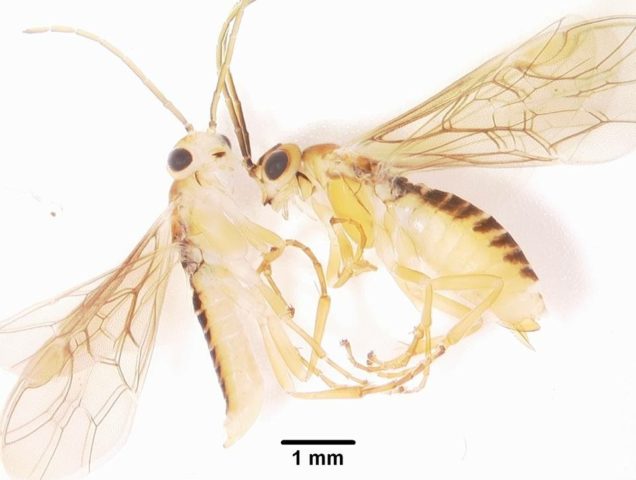Amy Dolan Discovers New Species of Insect
A shining star in the realm of everything curiosity, our very own middle school specialist, Amy Dolan, has been recognized for discovering a new species of insect — Pristiphora fructicola Smith and Dolan.
The new discovery, a species of sawfly, was discovered by Dolan in the summer of 2015 while she was working on her master’s degree in entomology research project at Montana State University.
“My thesis research was to investigate the insects associated with huckleberry plants in Montana,” Dolan explained. “No research on any pollinators or pests of huckleberries had ever been published. This meant that as soon as the snow melted in the summers of 2014 and 2015, I was hiking through forests in Montana looking for huckleberry plants and observing/collecting insects.”
In the summer of 2015, right as the flowering period of the plants ended, Dolan noticed there were many tiny yellow insects flying in and around the branches of the plants. She collected some, took them back to the lab, and looked at them under the microscope to try to identify them.
 “It turns out they were sawflies,” Dolan said. “Sawflies are related to bees and wasps and get their name from the fact that females literally have saws on their abdomens that allow them to cut into plants and lay eggs inside leaves or stems. “
“It turns out they were sawflies,” Dolan said. “Sawflies are related to bees and wasps and get their name from the fact that females literally have saws on their abdomens that allow them to cut into plants and lay eggs inside leaves or stems. “
Identifying insects is pretty challenging. You have to look for very subtle characteristics on tiny bodies. Dolan worked with her advisor to try to identify the sawflies she had found. Together, Dolan and her advisor were able to figure out the genus, but her specimens just didn’t match any of the known species descriptions.
“We sent photos and a sample to a sawfly expert at the National Museum of Natural History (Smithsonian) in D.C.,” Dolan said. “He compared my specimens with other species in the same genus and determined that it’s a new species.”
Insects are the most diverse animal group on earth, over 900,000 living species are known and scientists think that there could be 2-30 million total insect species on Earth. While there is quite a bit of discovery left, Dolan’s was surprising because of where it was discovered.
“What is a bit surprising about the discovery of this particular sawfly, however, is the fact that its plant host is the huckleberry plant, a plant visited by thousands of berry pickers in Montana each year,” Dolan said.
With everyone buzzing around Dolan’s new find, she said the first question people always ask her is if she will name the bug after herself.
Here’s Dolan’s answer:
“In order to give the species a name, you have to write a very detailed description of its physical characteristics that describes how the new species is distinct from other similar species. It’s bad form to name an insect after yourself, though you could name it after another person that you want to honor.
Usually the scientific name comes from Latin words that describe the physical appearance or location of the species. The name of the person who wrote the species description is part of the species’ official scientific name. My species is Pristiphora fructicola Smith and Dolan. Pristiphora is the genus it’s in, based on its physical characteristics. P. fructicola comes from Latin words for ‘fruit’ and ‘house’ since we found larvae living in the berries. David Smith is the sawfly expert at the Smithsonian who did most of the written description.”
Dolan’s constant curiosity keeps her excited to learn more about her sawfly.
“We don’t know details about the population, range or life cycle of P. fructicola,” Dolan said. “So there is still a lot of discovery yet to occur!”
“Curiosity may have ‘killed the cat,’ but it has nourished every good scientist.”
– Howard E. Evans, famous entomologist of the 20th century.





Leave a Reply
Want to join the discussion?Feel free to contribute!